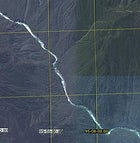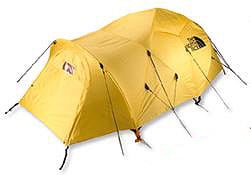How exactly do you go about getting 80 people, 14 boats, and several thousand pounds of equipment from one end of the deepest river canyon in the world to the other? You view it like a king-sized, 150-mile-long obstacle course fiendish enough to confound even the most talented river runners, Himalayan trekkers, and canyoneers, and plan accordingly. Success at making it from one end to the other will require—in addition to a very large pile of gear—perfect coordination between a paddling team and two ground teams, each with its own logistical challenges and objectives.
Tsangpo Gorge
 Eye in the sky: satellite close-up of the Tsangpo Gorge
Eye in the sky: satellite close-up of the Tsangpo GorgeChevrolet Avalanche
 Approach vehicle: The Chevrolet Avalanche
Approach vehicle: The Chevrolet Avalanche
Navigation
Satellite images provided by Space Imaging lent the team an eagle’s eye view of entire gorge in advance with detail never before available. Photographs showing rapids, side canyons, trails, and passes have been downloaded into the team’s laptop computers and on to CDs with resolution five times higher than what was possible just four years ago. Waypoints from the satellite images will be programmed into Garmin GPS receivers to keep the team on course. And, just in case of a major technological hiccup, they also have a complete set of ancient Russian topo maps.
Paddling
While February in the Himalayas might not seem like ideal kayaking weather, it is vital to attempt the river before the spring melt raises the river flow to impossible levels. Because hiking next to the river is impossible for much of the way, the seven paddlers will be out of reach of the ground teams for as much as five days at a time, so the boats are equipped with food, sleeping bags, and bivy shelters, as well as climbing gear in case the team becomes trapped by an unrunnable rapid and has to climb out. The kayaks used span a range of brands-Pyranha, Liquid Logic, Riot, and Perception-but are generally medium-volume models (70- to 75- gallon), large enough to carry gear but maneuverable enough to negotiate Class VI rapids. In deference to the extremely cold river water, the paddlers are wearing full dry suits with fleece underlayers.
Ground Teams
While the paddlers focus on navigating the river, the ground teams will face an equal challenge safely traversing the steep slopes and passes of the gorge. The primary ground team, led by David Allardice, who runs Nepal-based outfitter Ultimate Descents, will leave with the paddlers from Pe and attempt to parallel them downriver. The team will benefit greatly from the presence of Ken Storm, Jr., a five-time Tsangpo veteran. The second ground team, headed by Rob Hind, a former guide for Ultimate Descents, will start from the village of Pelung on the Po Tsangpo River and head downstream to rendezvous with the paddlers near the confluence. The expedition has hired five Nepali Sherpas, all of them with extensive Himalayan experience, to supervise the 60-plus local porters. Four of the Sherpas will accompany the primary ground team; the other will trek with the second team.
Mountaineering
One of the crux moves of the expedition will be when the paddlers leave the river to skirt the unrunnable section between Rainbow Falls and the confluence of the Po Tsangpo River. Then paddlers and ground team will climb to the 11,000-foot-plus Sechen La Pass before descending to the village of Payi and then on to the confluence. The conditions at the pass could still be icy and treacherous, so the group is equipped with crampons, ice axes, and avalanche probes and beacons. Primary ground team member and experienced mountaineer Andrew Sheppard will coordinate this section.
Communication
Communication equipment will provide a vital, and possibly lifesaving, link among the paddlers, between the paddlers and the ground teams, and between the expedition as a whole and the outside world. Iridium satellite telephones, with Web links via laptop computers, will handle communications between the ground teams and emergencies; ham radios will maintain the connection between the ground teams and paddlers, and the paddlers will use Motorola Talkabouts to stay in touch with each other. The ground team has a 1,000-watt Honda generator for major backup power and recharging the laptops, and the satellite telephones can be plugged into solar panels for recharging.
Mother Nature
In the upper, spruce-forested reaches of the gorge at or above 9,000 feet elevation, the climate is alpine, and frigid air masses sink off the ice-covered flanks of the peaks to sweep the river. Yet at the bottom, less than 1,000 feet above sea level, the Tsangpo runs through dense jungle-complete with leeches and venomous snakes. So expedition members will face conditions ranging from possible avalanches off the ice-covered slopes of Namcha Barwa and Gyala Pelri, to mud slides and hordes of insects. The teams will begin the journey layered in Gore-Tex and down, lugging four-season tents (they’ve even brought snowshoes), and probably wind up sweating, swatting, and wearing next to nothing.
Access
Getting from Tibet’s capital city of Lhasa into the gorge requires a 250-mile drive cresting over the 16,000-foot Mount Milha pass and terminating on the rough dirt roads along the Tsangpo’s right bank. Expedition sponsor Chevrolet Avalanche has airlifted three trucks to China to transport the team and their 14 kayaks and almost 2,000 pounds of gear. Once the team has completed the descent, the Avalanches will pick them at the town of Pelung, where the Po Tsangpo tributary intersects with the Friendship Highway.


